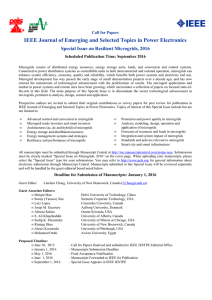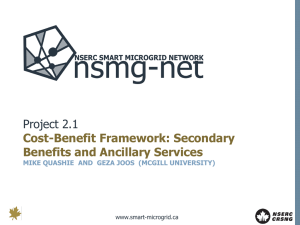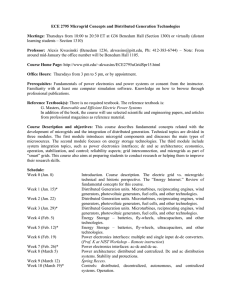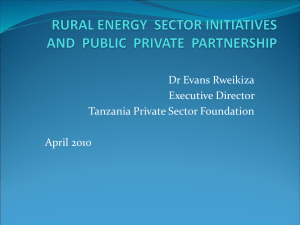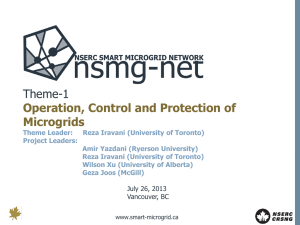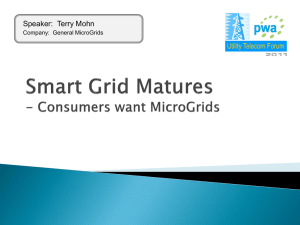Microgrids for Distributed Generation in Developing
advertisement
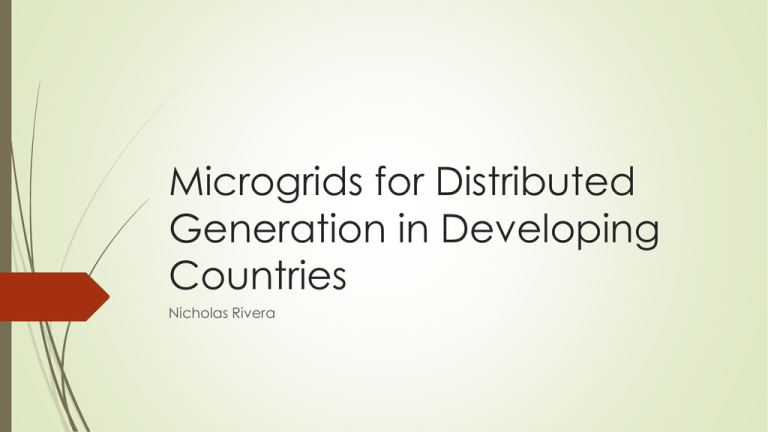
Microgrids for Distributed Generation in Developing Countries Nicholas Rivera Agenda Perspective Microgrids Distributed Generation Rural Electrification Case Study Takeaways Putting things into perspective Over 1.2 Billion people do not have access to electricity 550M in Africa 300M in India Current approach is to extend central grid Can be inefficient due to lack of capital and stresses to grid Multiple models to consider For-Profit Partially-Subsidized Fully Subsidized What is a Microgrid? Localized vs. vast Achieve local goals Reliability Carbon emission reduction Diverse energy portfolio Less transmission losses Function independently of, but still network with, the larger grid Distributed Generation Microgrids employ Diesel (most common) Solar photovoltaics Hydro Biomass Wind-diesel PV-diesel Often smaller scale/modular Can help prevent local blackouts/brownouts Rural Electrification - Benefits Replace low quality energy sources with cheaper, more efficient sources Electric lighting vs. kerosene lamps Improved health due to less reliance on biomass fuel Increased local education Wage improvement Increased potential for demand side management Rural Electrification - Challenges Lack of technical and business skills Difficulty limiting individual consumption Theft Community involvement needed throughout process Penalty enforcement Case Study: West Bengal Renewable Energy Development Agency (WBREDA) State agency tasked with implementing renewable energy Installed over 20 microgrids since 1993 18 PV 3 biomass 1 biomass/PV hybrid 1 wind/diesel hybrid WBREDA and municipal government split ownership of grids In some of the microgrid communities, beneficiary committees have assumed responsibilities of monitoring usage and enforcing penalties WBREDA: Economics 100% government subsidized microgrids Tariffs collected fund O&M expenses Salaries of maintenance contractor, linemen, spare parts Although existent for multiple years, there has been a price decrease from $12,000/kW installed to $4500/kW installed It is speculated that as of 2013, unit costs declined to $1800/kW installed Individuals pay for a fixed amount of energy Unit cost can vary by usage WBREDA: Challenges Electrification allowed for some individuals to obtain higher incomes In general, higher disposable income correlates to higher electricity consumption Increase in energy intensive appliance use Effort to control usage using current limiters Quickly rendered useless Performance may decrease or zero out upon the arrival and integration of the central grid Key Takeaways Microgrids can solve localized energy challenges When paired with distributed generation, consumers can be more active in selecting their energy sources Rural electrification can increase quality of life, public health, and financial stability (due to job creation) Despite benefits, there are always challenges to address References Department of Energy. "Energy.gov." Distributed Energy. N.p., n.d. Web. 19 Nov. 2014. Galvin Power. "What Are Smart Microgrids?" Home. N.p., n.d. Web. 19 Nov. 2014. Schnitzer, Daniel, Deepa S. Lounsbury, Juan P. Carvallo, Ranjit Deshmukh, Jay Apt, and Daniel M. Kammen. Microgrids for Rural Electrification. Rep. United Nations Foundation, n.d. Web. Feb. 2014.



